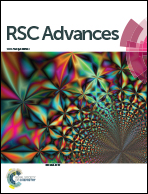Highly photoactive heterojunction based on g-C3N4 nanosheets decorated with dendritic zinc(ii) phthalocyanine through axial coordination and its ultrasensitive enzyme-free sensing of choline†
Abstract
A heterojunction with excellent photocatalytic performance based on graphene-like carbon nitride (g-C3N4) nanosheets and dendritic zinc(II) phthalocyanine was proposed. Herein, the g-C3N4 with excellent photo-activity and high nitrogen content was readily available as a functional material. The g-C3N4 acted as an electron pair donor for dendritic zinc(II) phthalocyanine through axial coordination, forming the p–n heterojunction. Then by taking advantage of the distortion of dendritic zinc(II) phthalocyanine, the spatial charge separation of photo-generated charge carriers in this metal macrocycle achieved high efficiency, resulting in the enhanced photo-to-electric conversion efficiency. Therefore, the optoelectronic sensing device based on the heterojunction led to an enhanced photocurrent, and made it a promising candidate for establishing photoelectrochemical biosensors. Moreover, the p–n heterojunction was successfully applied to the detection of choline with a wide linear range from 10 nM to 5 μM, which could be oxidized by the photo-generated holes. Along with these attractive features, the as-proposed biosensor also displayed a remarkable specificity against other interferents and could be successfully used for detecting choline in real samples. The heterojunction with enhanced photoelectronic properties provides a promising format for the future development of photoelectrochemical biosensors.


 Please wait while we load your content...
Please wait while we load your content...